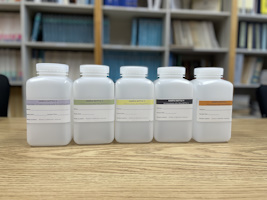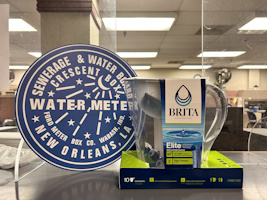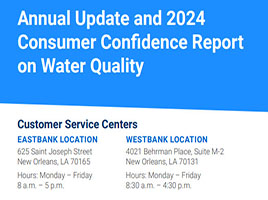Lead Awareness
Lead Awareness
New Orleans’ families deserve a lead-free water system. Removing lead pipes across the community is our long-term goal, and we are investing in a multi-year program to get us there, while working to protect public health today.
We recently mailed letters letting customers know their water line material.
While you do not need to take immediate action to replace your water line, there are actions you can take to protect your health.

The water that leaves our treatment plants is lead-free.
Protecting Your Family from Impacts of Lead Pipes in New Orleans
As a drinking water agency committed to public health, SWBNO recognizes the risk lead can present to our customers. There is no detectable lead in the water that leaves our treatment plants; however, lead can enter drinking water through lead pipes and fixtures in plumbing.
We know that lead pipes exist on both the customer-owned and utility-owned sides of the water system. Lead was a commonly used plumbing material for years before health impacts were known and it was banned in the plumbing industry in 1986. That’s why we have been confronting this challenge for years.
Our approach includes two main efforts:
- Corrosion control - We add lime, also known as calcium oxide, to our water before it ever leaves our treatment plants. Lime minimizes the tendency for lead to dissolve into the water from pipes while traveling to your home or business.
- Ongoing water testing across the system - This testing, done in compliance with state and federal regulations, is confirmation that corrosion control is working. We also test water samples from taps in homes and buildings that are at high risk of lead or copper contamination, following guidance from the U.S. Environmental Protection Agency (EPA).
Water Service Line Inventory
What is a service line?
Water service lines are the pipes that connect the water main to your meter and then connect your meter to your internal plumbing. The inventory assigns a category from the table above to each side of the meter, both SWBNO-owned and private-owned.
Checking Your Service Line Material
Similar to how a store takes an inventory of items in stock, our water service line inventory documents the materials used in all the water pipes in our drinking water system.
Search your address in the map below to check the status of your water service lines. A pop-up will appear with the status for both the public and private side of your meter. Check out the table below for how the categories are defined.

This map was last updated November 2025. We will continue to fine tune this tool as we collect more information and conduct inspections.
The service line category identifications, as legally required by the Environmental Protection Agency (EPA) were done in accordance with the EPA’s Lead and Copper Rule Revisions and subject to potential change.
Creating the Inventory
The inventory will include two types of data: verified and unknown. Based on this information, we will categorize your water line into one of six categories:
|
Verified Service Line Materials We have a record of the material. |
||
| Verified Lead: We have confirmed records that show the water line is made of lead. Lead service lines need to be replaced. | Verified Non-Lead: We have confirmed records that show the water line is not made of lead. Non-lead lines are any service line that is known to be safe. This can include PVC or other materials. | Galvanized: We have confirmed records that show the water line includes galvanized steel. Galvanized steel can trap lead particles and release them back into water over time. As a precaution, galvanized water service lines will need to be replaced. |
|
Unknown Service Line Materials We do not have record of your service line material. We used predictive modeling to make educated assumptions where we could based on data available. |
||
| Unknown: Unknown means there is little-to-no known data about the service line, and we did not have reliable data to use predictive modeling. SWBNO is working on a schedule to confirm the material of all unknown service lines across the city. | Assumed Lead (Unknown): Assumed lead means that the current pipe material is unknown, but our predictive model shows there is a high likelihood (80+% chance of being lead) the service line is lead. SWBNO is working on a schedule to confirm the material. | Assumed Non-Lead (Unknown): Based on our predictive model, the service line is likely not lead (20% chance or less of being lead). SWBNO is working on a schedule to confirm the material. |
Replacing Lead Lines
If we discover lead on both sides of the water line, The EPA’s Lead and Copper Rule Improvements require we are required to replace the entire water line (including the private side) according to the EPA’s Lead and Copper Rule Improvements.
Public Side: SWBNO is responsible for replacing the public side of a lead water line. full replacement of any lead service lines, including the private and public sides. The utility has secured public State Revolving Funds to support lead service line replacements on publicly-owned portions of water service lines.
Private Side: Property owners are typically responsible for the portion of the water line on their property. However, we are currently working on a legal pathway to utilize those public funds for replacements on private property.
If a property owner wishes to replace their private service line more immediately, customers are encouraged to inform SWBNO so our teams can replace the public side at the same time, if necessary. Building owners are still responsible for replacing lines within their homes or businesses.

Help Us Improve Our Inventory
Have information to help us update our service line material inventory? Fill out the form here to share information regarding your water service line or any concerns.
Lead Line Inventory Survey Correction FormPlease send your documentation to LSLR@swbno.org with your account number in the subject line. You must have formal documentation from a certified plumber. We will not accept photos of your water service line as documentation.
SWBNO’s Next Steps
Our utility is already taking steps to replace lead service lines. We have already begun lead service line replacements before the schedule established by the EPA’s Lead and Copper Rule Improvements, which were finalized on October 8, 2024.
Our Plan
- Long-Term: We are developing a Lead Service Line Replacement Plan. In November 2024, we began the search for a contractor to manage our lead service line replacement program. This contractor will manage all aspects of the project, including prioritizing replacements and inspections, communications, funding, construction, and more. The EPA’s recently finalized Lead and Copper Rule Improvements, establish a 10-year replacement timeline for this work starting in 2027.
-
Short-Term: We are not waiting for the award of this large contract to get started. In the meantime, we issued a smaller contract in late November to start work.
- So far, under this contract, SWBNO has completed 300 school inspections for lead service lines. This included inspections of both public and private service lines.
- SWBNO has also started its effort to replace 600 public-side lead service lines.
Funding
- We have already secured $86 million from the State Revolving Fund (SRF) for lead service line replacements. The loan closed in December 2024.
- We are also applying for $66 million available from the SRF to support lead service line replacements. SWBNO is the main water utility in Louisiana applying for these funds.
Pitcher Pick-Up Locations
Westbank Customer Service Center
- 4021 Behrman Place, Suite M-2, New Orleans, LA 70131
- Monday – Friday | 8:30 a.m. to 4:30 p.m.
St. Joseph St. Customer Service Center
- 625 St Joseph St, New Orleans, LA 70165
- Monday- Friday | 8:00 a.m. to 5:00 p.m.
Sanchez Center
- 1616 Fats Domino Ave, New Orleans, LA 70117
- Wednesdays and Thursdays | 8:00 a.m. to 4:00 p.m.
Frequently Asked Questions
Yes. There is no detectable lead in the water that leaves our treatment plants. The water that leaves our treatment plants meets all state and federal water quality standards.
However, we know lead exists in the pipes that bring water from our treatment plants to your home or business, both on the public and private sides of the system. An inventory showing pipe materials across the city is available above. You can use this tool to check the status of your water service line material.
For details about our water quality, view our Confidence Report.
Lead Pipes and Service Lines
What is the water service line inventory?Similar to how a store takes an inventory of items in stock, our water service line inventory documents the materials used in all the water pipes in our drinking water system.
Visit swbno.org/Projects/LeadAwareness to search your service address and check the material your water pipes are made of, both on the:
- SWBNO-owned public side (water main to meter)
- Private side (meter to building)
The inventory does not include plumbing or fixtures within your home or business.
Water service lines are the pipes that connect the water main to your meter and then connect your meter to your internal plumbing.
The EPA’s Lead and Copper Rule Improvements require full replacement of any lead service lines, including the private and public sides. The utility has secured public State Revolving Funds to support lead service line replacements. There is legislation underway that would allow SWBNO to utilize those funds for private replacements. The soonest that legislation could receive approval is in 2025. The utility would prioritize vulnerable populations first for both public and private replacements.
However, if a property owner wishes to replace their private service line now, customers are encouraged to inform SWBNO. Building owners are still responsible for replacing lines within their homes or businesses.
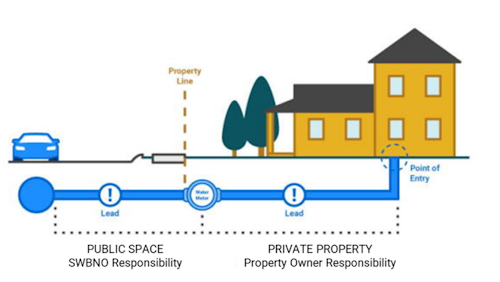
Yes, this is true for many older cities where lead pipes were commonly used in both utility-owned and customer-owned water service lines. Lead was a commonly used material for years before health impacts were known and it was banned in plumbing.
Although there is no detectable lead in the water that leaves our treatment plants, we know that lead pipes exist throughout the system—both on the customer-owned and utility-owned sides. For this reason, we have been actively taking steps for years to minimize the tendency for lead to dissolve into water. Testing of water across the system shows that SWBNO’s corrosion control measures have been effective.
Like many older cities where lead pipes were commonly used, New Orleans has plumbing with lead pipes throughout the water system. Some older homes may have premise plumbing and in-home fixtures that contain lead as well. Historically, no map or list of lead service lines has existed. That’s because many lead pipes exist on private property (the customer-owned side of the water system), and parts of SWBNO’s system are more than 100 years old.
The revised Lead and Copper Rule requires water systems to locate lead service lines and create a map-based inventory, which is now available above.
The inventory will be a searchable map showing the material of water service lines across the city. It includes a mix of 1) verified service line materials (we have record of the material) and 2) predicted service line materials (we don’t know the material but made an educated guess using a predictive model based on data available).
Predictive modeling used by SWBNO is based on:
- Existing records (including plumbing records and lead test kit results),
- meter install date,
- parcel data, and
- census data
The model was submitted to and approved by the Louisiana Department of Health. This data will be used to determine which service lines are prioritized for replacement as we work to remove lead from our water system.
The utility has secured public State Revolving Funds to support lead service line replacements. These public funds can directly support replacing publicly-owned (SWBNO-owned) portions of water service lines. We are currently working on a legal pathway to utilize those public funds for replacements on private property. The utility would prioritize vulnerable populations first for both public and private replacements.
However, if a property owner wishes to replace their private service line now, customers are encouraged to inform SWBNO. Building owners are still responsible for replacing lines within their homes or businesses.

Our inventory doesn’t currently show the material of your water service line. We are developing a schedule to confirm service line materials across New Orleans. We will update you once the timeline is available.
Have information to help us update our service line material inventory? Share documentation of your private service line material in the form above.
If you are concerned, you can take extra precautions by following these tips from the EPA:
- Use only cold water for drinking, cooking, and making baby formula.
- When water hasn’t been used for six hours or longer, run the faucet for three to five minutes to flush the lines before drinking or cooking with the water. Household tasks like showering or running the dishwasher can also help flush the system.
- Request a lead test kit by contacting SWBNO’s Lab at (504) 865-0420 or click here to use our online request form.
- Request to pick up a water pitcher that filters for lead by calling 52-WATER or click here to use our online request form.
- Use a filter that meets NSF Standard 53 as a recommended practice to help protect you and your family.
- If you have a lead service line on your property, replace it. The utility has secured public State Revolving Funds to support lead service line replacements. We are currently working on a legal pathway to utilize those public funds for replacements on private property.The utility would prioritize vulnerable populations first for both public and private replacements. However, if a property owner wishes to replace their private service line now, customers are encouraged to inform SWBNO. Building owners are still responsible for replacing lines within their homes or businesses.
- Review the latest SWBNO Consumer Confidence Report for more ideas.
Lead has adverse health effects, and the lead line will need to be replaced.
We have reduced the number of lead pipes on the utility-owned side of the water system where possible over the years. However, completely eliminating lead pipes across the entire community – including private property – will take careful planning over the next decade and beyond. Replacements will also need major funding support from federal and state sources.
SWBNO is developing a schedule for lead service line replacements across New Orleans. We will update you once the timeline is available.
Even if you have a lead pipe, it does not mean you have lead in your water. SWBNO practices effective corrosion control. We add lime, also known as calcium oxide, to our water before it ever leaves our treatment plants. Lime minimizes the tendency for lead to dissolve into the water from pipes while traveling to your home or business.
If you are concerned, you can take extra precautions by following these tips from the EPA:
- Use only cold water for drinking, cooking, and making baby formula.
- When water hasn’t been used for six hours or longer, run the faucet for three to five minutes to flush the lines before drinking or cooking with the water. Household tasks like showering or running the dishwasher can also help flush the system.
- Request a lead test kit by contacting SWBNO’s Lab at (504) 865-0420 or click here to use our online request form.
- Request to pick up a water pitcher that filters for lead by calling 52-WATER or click here to use our online request form.
- Use a filter that meets NSF Standard 53 as a recommended practice to help protect you and your family.
- If you have a lead service line on your property, replace it. The utility has secured public State Revolving Funds to support lead service line replacements. We are currently working on a legal pathway to utilize those public funds for replacements on private property. The utility would prioritize vulnerable populations first for both public and private replacements. However, if a property owner wishes to replace their private service line now, customers are encouraged to inform SWBNO. Building owners are still responsible for replacing lines within their homes or businesses.
- Review the latest SWBNO Consumer Confidence Report for more ideas.
Galvanized steel can trap lead particles and release them back into water over time. As a precaution, your water service line will need to be replaced. SWBNO is developing a schedule for service line replacements across New Orleans. We will update you once the timeline is available.
Even if you have galvanized steel pipes, it does not mean you have lead in your water. SWBNO practices effective corrosion control. We add lime, also known as calcium oxide, to our water before it ever leaves our treatment plants. Lime minimizes the tendency for lead to dissolve into the water from pipes while traveling to your home or business.
If you are concerned, you can take extra precautions by following these tips from the EPA:
- Use only cold water for drinking, cooking, and making baby formula.
- When water hasn’t been used for six hours or longer, run the faucet for three to five minutes to flush the lines before drinking or cooking with the water. Household tasks like showering or running the dishwasher can also help flush the system.
- Request a lead test kit by contacting SWBNO’s Lab at (504) 865-0420 or click here to use our online request form.
- Request to pick up a water pitcher that filters for lead by calling 52-WATER or click here to use our online request form.
- Use a filter that meets NSF Standard 53 as a recommended practice to help protect you and your family.
- If you have a lead service line on your property, replace it. The utility has secured public State Revolving Funds to support lead service line replacements. We are currently working on a legal pathway to utilize those public funds for replacements on private property. The utility would prioritize vulnerable populations first for both public and private replacements. However, if a property owner wishes to replace their private service line now, customers are encouraged to inform SWBNO. Building owners are still responsible for replacing lines within their homes or businesses.
- Review the latest SWBNO Consumer Confidence Report for more ideas.
Customers can request a lead testing kit online.
Depending on availability, a test kit with instructions will be mailed to your address. Results from lead testing takes approximately six to eight weeks. All results are provided by mail. If your results are above the EPA’s action level, you will also receive notification by phone or email.
Other certified laboratories can be found in your area by calling the Safe Drinking Water Hotline at 800-426-4791 or visiting www.epa.gov/safewater/labs.
Learn more about water testing here.
An online form is available for requesting a water filter pitcher with a 6-month filter.
SWBNO is committed to protecting customers from lead exposure, and we are pleased to provide at-risk customers with water pitchers that filter for lead, thanks to state and federal funding.
Please note that this funding requires us to prioritize pitchers for customers with lead, galvanized, or unknown service lines, based on our service line material inventory. To comply, we will review all requests and notify you of your eligibility. You should receive that notice the same day as your request, and you can pick up your pitcher as soon as your eligibility is confirmed.
Lead and Copper Rule (LCR)
What is the revised LCR?Lead was commonly used in plumbing in communities across the country for decades, long before the serious health effects of exposure to it were known.
In 1986, the federal Safe Drinking Water Act was amended to ban the use of lead in plumbing used for human consumption. However, if your home was constructed or if the plumbing was replaced prior to 1986, lead lines and fixtures may exist. It may also be present in the SWBNO-owned service lines leading to your meter, since much of our system is over 100 years old.
To address impacts of lead pipes in structures built before 1986, the U.S. Environmental Protection Agency enacted the Lead and Copper Rule (LCR) in 1991. It established steps utilities across the country, including SWBNO, must take to reduce lead exposure for local communities. The LCR has been revised several times since 1991. Most recently, the EPA issued its final Lead and Copper Rule Improvements on October 8, 2024, which establish a 10-year lead service line replacement timeline starting in 2027. SWBNO is currently working to comply with the latest revisions meant to add even more protections for you and your family. For more information, visit the EPA’s website.
There is no detectable lead in the water that leaves our treatment plants. However, lead can enter drinking water through lead pipes and fixtures in plumbing. We add lime, also known as calcium oxide, to our water before it ever leaves our treatment plants. This is known as “corrosion control.” Lime minimizes the tendency for lead to dissolve into the water from pipes while traveling to your home or business.
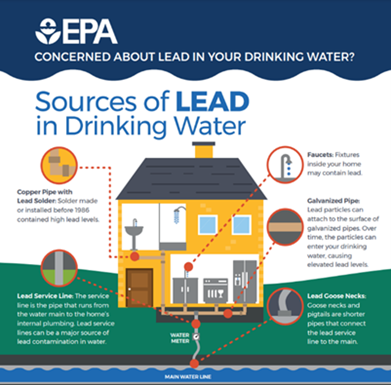
Lead was federally banned in the plumbing industry in 1986. Homes built after that year should not have lead plumbing or service line materials. If customers are concerned about lead, they can take the following steps to minimize their exposure:
- Use only cold water for drinking, cooking, and making baby formula.
- When water hasn’t been used for six hours or longer, run the faucet for three to five minutes to flush the lines before drinking or cooking with the water. Household tasks like showering or running the dishwasher can also help flush the system.
- Request a lead test kit by contacting SWBNO’s Lab at (504) 865-0420 or click here to use our online request form.
- Request to pick up a water pitcher that filters for lead by calling 52-WATER or click here to use our online request form.
- Use a filter that meets NSF Standard 53 as a recommended practice to help protect you and your family.
- If you have a lead service line on your property, replace it. SWBNO can coordinate to replace the public side of the lead line at the same time.
- Review the latest SWBNO Consumer Confidence Report for more ideas.
For more information, view these tips from the EPA.
There is no safe level of lead in drinking water. Exposure to lead in drinking water can cause serious health effects in all age groups, especially pregnant people, infants (both formula-fed and breastfed), and young children.
Some of the health effects to infants and children include decreases in IQ and attention span. Lead exposure can also result in new or worsened learning and behavior problems. The children of persons who are exposed to lead before or during pregnancy may be at increased risk of these harmful health effects.
Adults have increased risks of heart disease, high blood pressure, kidney or nervous system problems.
Contact your health care provider for more information about your risks.
